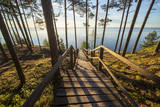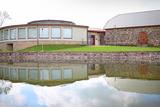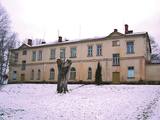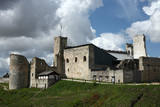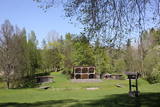| Nr | Name | Beschreibung |
|---|---|---|
|
In der gut geführten Gärtnerei, die über 3000 Arten, Formen und Sorten von Pflanzen hat, werden Führungen angeboten. Eine Besonderheit ist das breite Angebot an Wasserpflanzen. Neben dem Verkauf der Pflanzen gibt es Beratungen zur Standortwahl und Pflege. |
||
|
The Narūta River which flows out of Lake Ežezers is approximately 1 km long and ends at the small Obiteļi windmill lake. On the right bank of the river is a windmill that was built around 1900. Today the site has the Obiteļa leisure centre with a sauna and banquet facilities. |
||
|
Atrodas nepilnus 2 km austrumos no Aglonas, Aglonas – Dagdas ceļa malā. Tā ieceres autors ir Ēriks Delpers, kurš 2006. g. uzsāka vietas labiekārtošanu, izveidojot brīvdabas skulptūru dārzu un stādījumus. Kristus Karaļa kalns šobrīd atrodas izveides procesā, taču neskatoties uz to – objekts, ko ir vērts redzēt! |
||
|
Die Steilküste von Ēvaži mit ihren Küstenwäldern ist eine der wenigen Steilküsten an der Rigaer Bucht. Über die nach dem letzten schweren Sturm erneuerten Treppen gelangt man an den ungewöhnlichen, schmalen Sandstrand, der bei Stürmen unter den Wellen verschwindet.
|
||
|
Ein zeitgemäßes und modernes Zentrum in einem historischen Scheunengebäude bildet einen einmaligen Komplex, in dem man eine Ausstellung über die Geschichte des Handwerks findet, das Glasmuseum, einen weiteren Ausstellungssaal, den längsten Gürtel der lettischen Volkstracht, einen Konferenzsaal, eine Wassergalerie. In den Werkstätten kann man Handwerkern der Umgebung, Töpfern, Texilherstellern, Glasbläsern bei der Arbeit zusehen und auch selbst mitwirken. |
||
|
Established: 1890. The Wagner Garden is located near Lake Jumprava. Its originator was Friedrich Wagner, who grew fruit trees, decorative shrubs and flowers. This garden contains one of Latvia’s oldest and best collections of foreign trees and shrubs. There are trails for perambulations in the park.
Unique species: Todo Fir (Abies mayriana), among others. Guides for groups and individuals; please contact the garden in advance. Sale of plants
|
||
|
In the southern part of Līvāni, where Zemgales Street ends at the Daugava River, there is a fairly unusual and exotic form of transportation – one of three river crossings in Latvia. Unlike the one in Līgatne, this one is operated by a motor, not the flow of the river. It involves a cable across the river, and it is based on Soviet military pontoons that were used to build pontoon bridges for tanks. The crossing point was established by its owners. |
||
|
Die Holzkirche wurde 1766 erbaut, die neue Mauerkirche wurde anstelle der alten Kirche 1868 errichtet und eingeweiht. Der hohe Turm diente während der Tageszeit als Orientierungspunkt für Schiffe. 1993 wurde das Altarbild der Künstlerin Gunta Liepiņa-Grīva „Christus und Petrus auf dem Meer“ eingeweiht, das anstelle des verlorenen Gemäldes gemalt wurde. Am 18. November 1923 wurde im nebenliegenden Pfarrhaus von Mazirbe (heute das Zentrum für Rekollektion) die blau-grün-weiße livische Flagge eingeweiht. In der Umgebung des Pfarrhauses kann man Messsteine von Mazirbe, Zeugen des Schwarzen Todes (1710, 1711), finden. Der lateinische Text auf den Steinen deutete, dass die Liven des Küstengebietes durch Karl IX. und Pest überwältigt wurden. Der Text auf den Steinen ist nicht mehr lesbar, wurde jedoch entschlüsselt und ist bekannt. Auf dem Friedhof von Mazirbe ist das Denkmal des Alten Taizelis, ein Denkmal für die Eltern des Kapitäns A. Bertholds und die Grabstätte des legendären Werwolfs, zu sehen. |
||
|
You will feel the beauty, power and energy of nature here, ensuring harmony with nature and a good sense of the energy of rocks, plants, Latvian plants and underground streams. Rocks here decorate the garden, which offers a good view of the sea and a cascade of waterfalls that are delightful in the spring and the fall. During the summer, it is a rock river. The site is one km to the north of the bus stop in Tūja and has 28 types of coniferous trees, 14 decorative shrubs, 13 kinds of rhododendrons, and winter plants. The interesting collection of stones may mean that there is an energy field, and the garden is quite esoteric. The rocky seashore of Vidzeme is nearby, and the garden has received many prizes from the Salacgrīva Administrative District and Latvia as such. |
||
|
Bikovas Manor. The name of this manor is listed in the chronicle since the 17th century. You should see the manor house
and the park where you can find a stone chapel that was built in 1820, servant’s house, several household buildings
and stablings. After the fire of 1905, the building was reconstructed and the second floor was built. Since
1937, the manor is serving as Gaigalava Secondary school. According to the legend, there are secret passages that
lead to the church and the cemetery. The building is the architectural monument of local importance.
|
||
|
Маршрут подходит для активных туристов, интересующихся многообразием природной и культурной среды национального парка «Кемери». Национальный парк «Кемери» (основан в 1997 г.) создан, прежде всего, для защиты водноболотных угодий – мелководного побережья Рижского залива, заросших прибрежных озер, болот, влажных лесов (трясин и др.) и пойменных лугов, как значимых мест произростания многих растений (~ 25 % от видов растений, занесенных в Красную книгу Латвии) и обитания животных, особенно мест скопления гнездящихся и перелетных птиц. На территории парка находится один из крупнейших заболоченных массивов Латвии – Большое Кемерское болото. Заболоченные массивы являются значимым местом образования и выхода сероводородных вод, а также местонахождения лечебных грязей, используемых в медицине, которые в свое время послужили основанием для создания известного курорта «Кемери». Информация о маршруте от Latvijas Lauku forums |
||
|
Der Betrieb befindet sich im Zentrum von Raiskums, im Gebäude der ehemaligen Kornkammer des Landguts. Es werden nach alten Traditionen und Rezepten der Vorfahren Bier gebraut, Brot gebacken und Fleisch geräuchert. Den besonderen Geschmack verleiht der mit Holz geheizte Bierkochkessel und alten Brotofen. Führung durch den Betrieb und Verkostung. |
||
|
Der Name von Cesvaine ist in den schriftlichen Quellen zum ersten Mal im Jahr 1209 erwähnt worden. Jeder, der Lettland bereist, denkt an Cesvaine in Verbindung mit der Familie der Barone von Wolf, die im Jahr 1815 das Landgut von Cesvaine erworben hat. Die wirtschaftliche Blütezeit von Cesvaine begann nach dem Bau der Eisenbahn zwischen Pļaviņas und Gulbene. Die Stadt hat während des Zweiten Weltkriegs gelitten. Im Jahr 2002 fand in dem Schloss von Cesvaine eine Tragödie statt: In einem Brand wurde der größte Teil der Burg zerstört. Nach einer großen Unterstützung der Gesellschaft, des Staates und der Selbstverwaltung ‘erholt sich‘ jetzt das Schloss und es hält immer noch den Ruf als eine bekannte Sehenswürdigkeit nicht nur in der Region Vidzeme, sondern auch im ganzen Lettland. |
||
|
Die Burg von Rakvere ist heute ein Themenpark aus 16. Jh und bietet spannende Erlebnisse für die ganze Familie. Hier sind Pferde zum Reiten, man kann Bogen- und Armbrustschiessen, Schmiedarbeit und Zimmerhandwerk probieren, Münzen schlagen, Gold giessen und Schiesspulver anfertigen. Besuchen sie den Weinkeller, die Folterkammer, Todeskammer, das mittelalterliche Freudenhaus, die Werkstuben des Barbiers und Alchemisten und das Astronomiezimmer. In der Burg befindet sich die Kneipe von Shenkenberg, wo die Speisen nach mittelalterlichen Rezepten zubereitet werden. |
||
|
Das Gebäude befindet sich in der Brīvības Straße 125 a. Auf einem Spaziergang durch die Stadt ist es wert, dem ältesten Gebäude der Stadt Aufmerksamkeit zu schenken. Es befindet sich unweit von der evangelisch-lutherischen Kirche des Heiligen Michaels in Jēkabpils (Eigentum der Gemeinde; mit dem Bau wurde im Jahr 1769 begonnen). Das Holzgebäude ist im Jahr 1808 gebaut worden. |
||
|
Dieser Friedhof hat sich in den 1960er Jahren gebildet, als die Sowjetarmee den Fischfang an der Küste einzugrenzen versuchte. Die Boote hatten mehr keine Anwendung und sie wurden in den Küstendünen abgestellt. Unterwegs zum Bootsfriedhof kann man eine große Netzscheune von außen besichtigen. |
||
|
(In Silmači spielt ein beliebtes Theaterstück des lettischen Dichters Rudolfs Blaumanis, das allerjährlich zur Sommersonnenwende vielerorts aufgeführt wird: Schneidertage in Silmači („Skroderdienas Silmačos”). Nach Silmači muss man durch den Pērļu sils (Perlen- Kiefernwäldchen) und wenig bewohnte Orte fahren. In Silmači war in den 80er Jahren eine Freilichtbühne eigens für die Aufführung diese Stückes gebaut worden, die das Lettische Nationaltheater zur Sommersonnenwende (Ligo-Fest) 1986 am Originalschauplatz spielte. Zu diesem Anlass wurde auch neben der Bühne ein Museum eingerichtet, dessen Exposition der Thematik gewidmet ist. Hier kann man unter anderem auch das Originalmanuskript des Stückes von 1902 sehen. |
||
|
This is a “peripheral” island in the Bay of Finland, 9 km from the Dirhami port. The special fact about this island is that it offers fields of juniper, a rocky and grassy seashore that is around 2 km long, and limestone cliffs that are a few metres high along the northern and the eastern shores of the island. These are designated with the words Osmussaare pank.
|
||
|
In der Umgebung von der 52 m hohen Parniddenen Düne sind die im 18. Jh. bei einem Holzeinschlag entstandene Wanderdünen zu sehen! Aussichtsplatz. |
||
|
Auf der Route kann man einzigartige und in Lettland bisher noch nicht gesehene Landschaften sehen! Die eindrucksvolle Steilküste der Ostsee beginnt einige Kilometer nördlich des Dorfs Pāvilosta, endet kurz vor dem Dorf Ošvalki und sie ist fast zwanzig Kilometer lang. Ihre eindrucksvollsten und einzigartigsten Formen sind auf der Strecke Strante – Ulmale zu besichtigen. Die ganze Route führt auf der ehemaligen westlichen Grenze des Eisernen Vorhangs, weil die Küste der Ostsee während der Sowjetzeit eine Militärzone und einfachen Menschen nicht zugänglich war. Auch heute kann man noch die Reste der Militärobjekte und die alten Wege der Panzer in den Küstendünen sehen. In der Umgebung von Ventspils und Užava dehnen sich kilometerlang die in den baltischen Ländern größten Biotope der grauen Dünen. Diese Landschaften sind ungewöhnlich und anderswo in Europa ganz selten zu sehen. Hier kann man mehr als zehn Kilometer wandern, ohne einen Menschen zu treffen. Route information from Latvijas Lauku forums |
||



